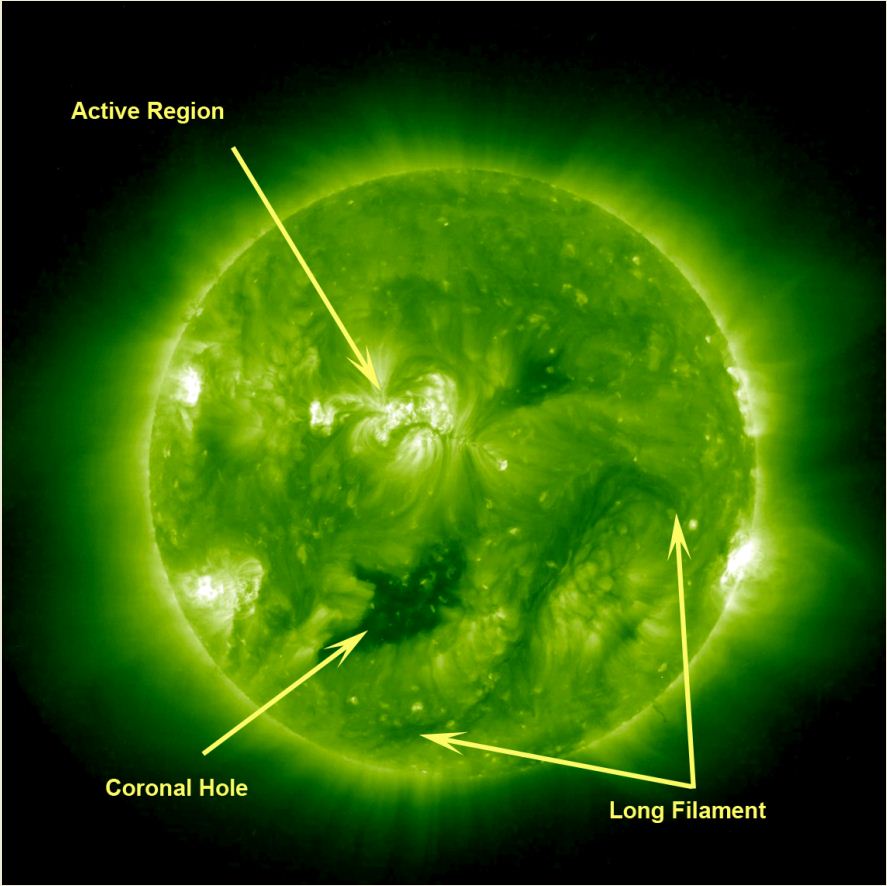New Scientist article 14 June 2011 by David Shiga
This single STEREO image (June 27, 2011) in extreme UV light from the Ahead spacecraft contains three major, magnetic solar features, all clearly identifiable: a coronal hole, an active region, and a long filament.
The coronal hole is a dark area, where there is less material in the wavelength being imaged and from which streams high-speed solar wind. The large, central active region (and there are a few others) is actually a group of active regions, often the source of solar storms. These areas appear brighter in extreme UV light. Lastly, a long, meandering filament stretches across more than half the width of the Sun, over 500,000 miles. These are clouds of cooler gases that hover above the Sun?s surface, suspended by magnetic forces. While all three features are fairly common, they do not usually appear to stand out so well at the same time.
The eerily lethargic sun shows no signs of perking up, solar physicists say. The sun may wallow in inactivity for the next decade – or longer, which could affect Earth’s climate as well as the health of orbiting satellites.
The sun has been unusually placid lately. In 2008, the solar wind slowed to a 50-year low, coinciding with the least active point in the 11-year sunspot cycle. That dip in activity has also been deeper and longer than usual.
Now, other diagnostic measurements of the sun also point to weird behaviour, suggesting the normal sunspot cycle may be interrupted.
“The sunspot cycle may be going into hibernation,” says Frank Hill of the National Solar Observatory in Sunspot, New Mexico. He and other researchers are presenting their findings this week at a meeting of the American Astronomical Society’s Solar Physics Division in Las Cruces, New Mexico.
Too weak
Solar cycle peaks are normally preceded by bright disturbances in the sun’s wispy outer atmosphere or corona. Over several years, these drift towards the sun’s poles after starting at lower latitudes.
But these migrating disturbances have not shown up on schedule for the next predicted maximum in 2013, say researchers led by Richard Altrock of the National Solar Observatory. “We’ll see a very weak solar maximum in 2013, if at all,” Altrock predicts.
And the sun may sit out the following solar maximum as well. Another team led by William Livingston, also of the National Solar Observatory, has observed magnetic fields necessary to produce sunspots steadily weakening for the past 13 years. If the trend continues, the fields may be too weak to birth new sunspots for the following cycle in 2022, they say.
A third team led by Hill has been tracking winds that blow beneath the sun’s visible surface. A wind pattern that preceded previous solar cycle peaks has not appeared on schedule, which is another indication that the normal behaviour has broken down, they say.
Shields are down
The peak of the solar cycle, when sunspots are abundant, tends to unleash more outbursts of plasma from the sun, which can fry satellite electronics and interfere with radio communication and power grids on Earth. If the sun becomes especially quiet, these storms may be fewer and farther between.


